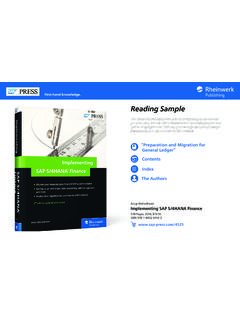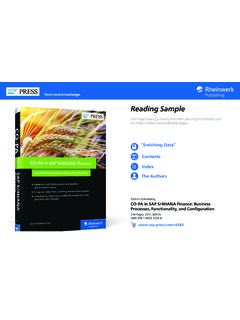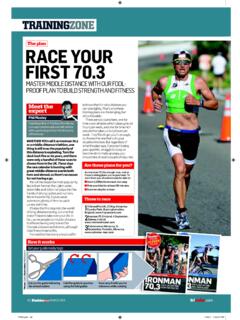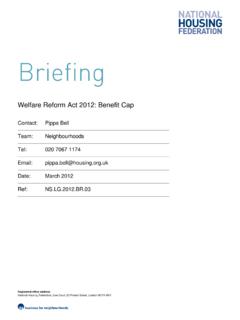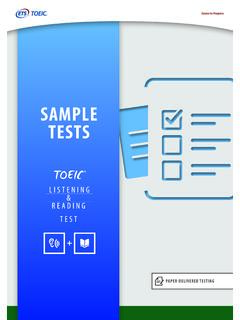Transcription of “Material Master Data” Contents Index The Authors
1 First-hand knowledge. Browse the Book This sample chapter discusses the basic structure of the material Master and reviews the data entry screens for basic data, classification, purcha- sing, sales org. It also covers the material requirements planning, fo- recasting, accounting, and costing views. material Master Data . Contents Index The Authors Jawad Akhtar, Martin Murray Materials Management with SAP S/4 HANA. 939 Pages, 2020, $ ISBN 978-1-4932-1995-7. Chapter 4. material Master Data Data entered into the material Master is extremely important to an 4.
2 SAP implementation. Incorrect, incomplete, or missing data can bring operations to a screeching halt. Understanding how to enter correct data into the material Master is vital for all SAP components. In this chapter, we'll discuss the basic structure of the material Master and review the data entry screens for basic data, classification, purchasing, sales org, and material requirements planning, forecasting, accounting, costing views among others. Under- standing what a field in the material Master is and how it relates to data in your leg- acy systems is crucially important.
3 Data conversions are rarely treated with the importance they deserve. The earlier in the implementation the team works on understanding the data in the SAP Master files, the more time will be available for correctly converting legacy data and creating data that doesn't reside in the legacy files. Prior to starting any implementation, we recommend starting parallel projects for cleansing legacy data and eradicating duplicate and redundant records. Often, com- panies have many duplicate records for one vendor or for materials that are obsolete, which should be identified and corrected before any data is loaded into SAP.
4 Main- taining a correct, complete, and comprehensive set of Master data is key to a success- ful SAP implementation project, and this data should be constantly cleansed, refined, and improved over time. A company may have more than one legacy system and may be combining and load- ing Master data from several systems into one SAP system. The more complicated the data rationalization task, the earlier the company needs to start ensuring the suc- cessful loading of data into SAP before the implementation goes live. As mentioned earlier, a complete, correct, and comprehensive set of Master data is needed to ensure that business processes run smoothly in the SAP system.
5 101. 4 material Master Data material Type Industry Sector Note During an SAP implementation project, the configuration objects are first decided A configured industry sector must be assigned for each material Master record added. and agreed upon with relevant stakeholders. These objects are configured in the SAP In general, most SAP customers use just one industry sector for all their material system by consultants. These configured objects are then assigned to the Master Master records, but this limit isn't mandatory. 4. data. Transactions or business processes then use the Master data.
6 Finally, reporting An SAP system has four predefined industry sectors: functions, whether for standard SAP reports or custom reports, will use configured P: For the pharmaceutical sector objects, Master data, and transactions. C: For the chemical industry sector For example, the logical sequence of how these four elements work follows this order: M: For the mechanical engineering sector 1. As described in Chapter 2, we configured a new purchasing organization 6000. and a new plant 6000. A: For plant engineering and construction 2. These two objects are then assigned to the material Master , which is Master Defining a new industry sector requires choosing a single character to identify the data, as will be discussed throughout this chapter.
7 Supplier or vendor Master industry sector and providing a description. The new industry sector must be linked data (now called business partner Master data) is MM Master data, which can be to a field reference, which we discussed in Chapter 3. A field reference consists of a list assigned to a purchasing organization. We'll cover this process in Chapter 5. of material Master fields and an indicator determining whether an individual field is 3. Business processes or transactional data, such as a purchase order of a material - hidden or displayed, optional or required.
8 Exercise careful consideration when con- vendor combination, will use the Master data we created in the previous step. figuring new field references. We'll cover this process in Chapter 10. 4. Finally, a few standard purchasing or inventory reports can be created to use plant, purchasing organization, material Master , or vendor Master data as selec- material Type tion criteria. We'll cover these reporting and evaluation topics in Chapter 27. A material type is a group of materials with similar attributes. material types allow for To summarize, configuration is a backend SAP system activity and must occur only the management of different materials in a uniform manner.
9 For example, a material once during an SAP implementation project. Master data is a frontend input activity type can group together materials that are purchased or produced internally or that that also often happens only once or only occasionally. Master data remains largely have no value. SAP delivers a set of standard, predefined material types, but you can unchanged for a much longer period of time and is used in routine business transac- also create new material types, which we covered in Chapter 3. tions. Transactions or business processes, such as creating a purchase requisition, a purchase order, a goods issuance, or a goods receipt are again input activities and take place as frequently as needed.
10 Finally, reporting and analysis, for example, to Standard material Types determine the number of open purchase orders or to identify vendors who delivered goods but haven't been paid, are outputs of all these previous input activities. A number of SAP-delivered material types can be used without needing to configure any new material types. In this section, we'll discuss standard material types. Al- An SAP consultant must always stay focused on the output (reporting) during the SAP. though new material types can be configured, the added complication of additional implementation project.
